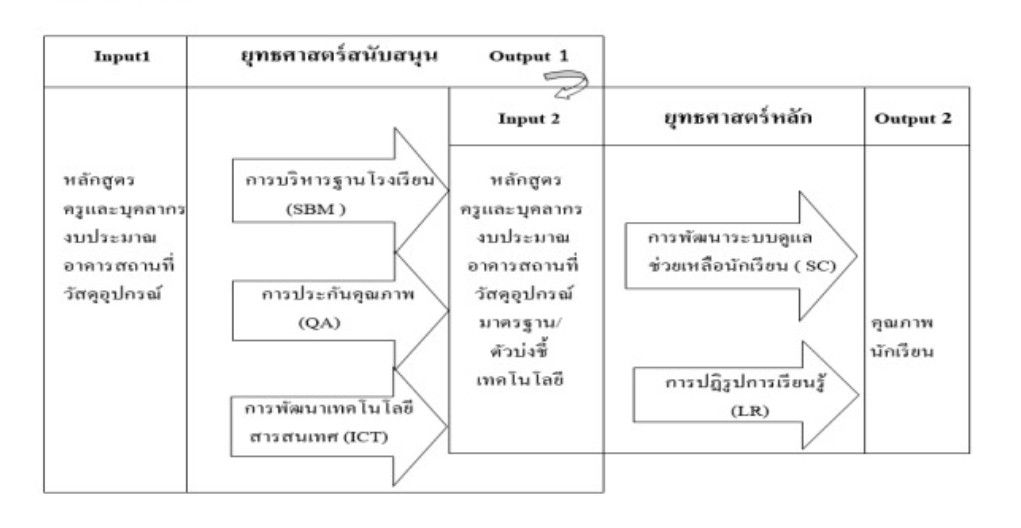การวิจัยและพัฒนายุทธศาสตร์การบริหารแบบหลอมรวมเพื่อนำไปสู่การปฏิรูปการเรียนรู้
Main Article Content
บทคัดย่อ
การวิจัยครั้งนี้มีวัตถุประสงค์คือ 1) เพื่อศึกษาและพัฒนายุทธศาสตร์การบริหารแบบหลอมรวมเพื่อนำไปสู่การปฏิรูปการเรียนรู้ในสถานศึกษา 2) เพื่อทดลองและศึกษาผลของยุทธศาสตร์การบริหารแบบหลอมรวมในสถานศึกษาที่มีต่อผลผลิตของสถานศึกษา และ3) เพื่อปรับปรุงยุทธศาสตร์การบริหารแบบหลอมรวมหลังจากทดลองใช้ในสถานศึกษาแล้ว กลุ่มตัวอย่างในการวิจัย ประกอบด้วย ผู้บริหารสถานศึกษาและครูในสถานศึกษาในจังหวัดเพชรบุรี 6 แห่ง ได้แก่ สถานศึกษาต้นแบบ 1 โรงเรียน (โรงเรียนเบญจมเทพอุทิศจังหวัดเพชรบุรี) สถานศึกษาเครือข่าย 4 โรงเรียน และสถานศึกษานอกเครือข่าย 1 โรงเรียน รวมทั้งสิ้น 374 คน การทดลองยุทธศาสตร์การบริหารแบบหลอมรวมแบ่งเป็น 3 ระยะ คือ ระยะที่ 1 เป็นการทดลองยุทธศาสตร์การบริหารแบบหลอมรวมกับสถานศึกษาต้นแบบ 1 โรงเรียน ระยะที่ 2 เป็นการทดลองยุทธศาสตร์การบริหารแบบหลอมรวมในสถานศึกษาต้นแบบ สถานศึกษาเครือข่าย 4 โรงเรียน และสถานศึกษานอกเครือข่าย 1 โรงเรียน ระยะที่ 3 เป็นการทดลองยุทธศาสตร์การบริหารแบบหลอมรวมที่ปรับใหม่แล้วกับสถานศึกษาต้นแบบ ระยะเวลาในการทดลองอยู่ในระหว่างปีการศึกษา 2545 ถึงปีการศึกษา 2548 เครื่องมือที่ใช้ในการวิจัยประกอบด้วย 1) ยุทธศาสตร์การบริหารแบบหลอมรวมที่อยู่ในรูปคู่มือการบริหาร 2) แบบประเมินการดำเนินงานยุทธศาสตร์การบริหารแบบหลอมรวม 3) แบบบันทึกเพื่อเก็บข้อมูลผลผลิตของโรงเรียน ได้แก่ ผลผลิตด้านนักเรียน ผลผลิตด้านครู และผลผลิตภาพรวมของโรงเรียน โดยเก็บข้อมูลทั้งเชิงคุณภาพและเชิงปริมาณ การวิเคราะห์ข้อมูลเชิงปริมาณใช้ค่าร้อยละ ค่าเฉลี่ย ค่าเบี่ยงเบนมาตรฐาน สถิติทดสอบที และสถิติทดสอบเอฟ ผลการวิจัยพบว่า ยุทธศาสตร์การบริหารแบบหลอมรวมเป็นรูปแบบการบริหารที่ผู้บริหารสถานศึกษาต้นแบบนำหัวหน้างานของ 5 ยุทธศาสตร์ย่อย ซึ่งได้แก่ การบริหารแบบฐานโรงเรียน การปฏิรูปการเรียนรู้ การประกันคุณภาพการศึกษา การพัฒนาระบบดูแลช่วยเหลือนักเรียน และการพัฒนาเทคโนโลยีสารสนเทศมาแต่งตั้งเป็นคณะกรรมการโดยให้ชื่อว่า ศูนย์ประสานงานซึ่งทำหน้าที่ประสานงานดูแลให้งานของ 5 ยุทธศาสตร์ย่อยให้สอดประสานกันผลการทดลองยุทธศาสตร์การบริหารแบบหลอมรวมในสถานศึกษา พบว่า ผลการทดลองในระยะที่ 1 พบว่า ยุทธศาสตร์การบริหารแบบหลอมรวมมีผลต่อการดำเนินงานยุทธศาสตร์การบริหารแบบหลอมรวมของบุคลากรในโรงเรียนเบญจมเทพอุทิศจังหวัดเพชรบุรี การดำเนินงานตามยุทธศาสตร์หลังการทดลองสูงกว่าก่อนการทดลองอย่างมีนัยสำคัญทางสถิติที่ระดับ 0.05 ผลการทดลองในระยะที่ 2 พบว่า สถานศึกษาต้นแบบ สถานศึกษาเครือข่าย และสถานศึกษานอกเครือข่าย มีการดำเนินงานยุทธศาสตร์การบริหารแบบหลอมรวม หลังการทดลองสูงกว่าก่อนการทดลอง อย่างมีนัยสำคัญทางสถิติที่ระดับ 0.05 ผลการดำเนินงานตามยุทธศาสตร์ของสถานศึกษาต้นแบบสูงกว่าทุกโรงเรียน และพบว่าผลการดำเนินงานยุทธศาสตร์ของสถานศึกษานอกเครือข่ายสูงกว่าผลการดำเนินงานของสถานศึกษาเครือข่าย 1 โรงเรียน อย่างมีนัยสำคัญทางสถิติที่ระดับ 0.05 ผลการทดลองในระยะที่ 3 พบว่า ผลการดำเนินงานตามยุทธศาสตร์การบริหารแบบหลอมรวมที่ปรับเปลี่ยนแล้ว ทำให้โรงเรียนเบญจมเทพอุทิศจังหวัดเพชรบุรีเป็นโรงเรียนแห่งคุณภาพและการสร้างสรรค์ เมื่อวัดจากผลผลิตด้านนักเรียน ผลผลิตด้านครู และผลการดำเนินงานของโรงเรียน หลังทดลองใช้ยุทธศาสตร์การบริหารแบบหลอมรวมมีแนวโน้มสูงกว่าการบริหารแบบเดิม การบริหารยุทธศาสตร์แบบหลอมรวมที่ปรับใหม่จะเป็นรูปแบบการบริหารที่ประกอบด้วย 5 ยุทธศาสตร์ย่อยเหมือนเดิม แต่ความสำคัญทั้ง 5 ยุทธศาสตร์จะถูกแบ่งเป็น 2 ยุทธศาสตร์หลัก และ 3 ยุทธศาสตร์สนับสนุน ซึ่งยุทธศาสตร์หลัก คือ ยุทธศาสตร์ปฏิรูปการเรียนรู้และยุทธศาสตร์ระบบดูแลช่วยเหลือนักเรียน ส่วนยุทธศาสตร์สนับสนุน ประกอบด้วย ยุทธศาสตร์การบริหารแบบฐานโรงเรียน ยุทธศาสตร์การพัฒนาระบบการประกันคุณภาพ และยุทธศาสตร์การพัฒนาเทคโนโลยีสารสนเทศ ซึ่งพบว่ายุทธศาสตร์สนับสนุนทั้ง 3 ยุทธศาสตร์ ส่งผลต่อความสมบูรณ์ของปัจจัยการจัดการศึกษาของสถานศึกษา และนำมาเป็นปัจจัยพร้อมสำหรับการดำเนินงานยุทธศาสตร์หลักอีก 2 ยุทธศาสตร์ ได้อย่างมีประสิทธิภาพและสร้างสรรค์ และส่งผลให้โรงเรียนเป็นองค์กรแห่งการเรียนรู้ และโรงเรียนแห่งคุณภาพ
Article Details
เอกสารอ้างอิง
กระทรวงศึกษาธิการ. (2542). การปฏิรูประบบบริหารการศึกษาในกระทรวงศึกษาธิการ. กรุงเทพมหานคร: การศาสนา.
เกรียงศักดิ์ เจริญวงศ์ศักดิ์. (2545). วิเคราะห์พระราชบัญญัติการศึกษาแห่งชาติจากมุมมองทางเศรษฐศาสตร์. ในธีระ รุญเจริญ และคณะ การบริหารเพื่อการปฏิรูปการเรียนรู้ (หน้า 53 – 71 ). กรุงเทพมหานคร : บริษัทเยลโล่การพิมพ์ (1988) จำกัด.
เฉลียว บุรีภักดี. (2546). หลักการพัฒนาและการสร้างยุทธศาสตร์การพัฒนา. เพชรบุรี: สถาบัน ราชภัฏเพชรบุรี.
โรงเรียนเบญจมเทพอุทิศจังหวัดเพชรบุรี. (2546). รายงานการประเมินตนเองของสถานศึกษาปีการศึกษา 2545. เพชรบุรี : โรงเรียนเบญจมเทพอุทิศจังหวัดเพชรบุรี.
โรงเรียนเบญจมเทพอุทิศจังหวัดเพชรบุรี. (2547). รายงานการประเมินตนเองของสถานศึกษาปีการศึกษา2546. เพชรบุรี : โรงเรียนเบญจมเทพอุทิศจังหวัดเพชรบุรี.
โรงเรียนเบญจมเทพอุทิศจังหวัดเพชรบุรี. (2548). รายงานการประเมินตนเองของสถานศึกษาปีการศึกษา 2547. เพชรบุรี : โรงเรียนเบญจมเทพอุทิศจังหวัดเพชรบุรี.
โรงเรียนเบญจมเทพอุทิศจังหวัดเพชรบุรี. (2549). รายงานการประเมินตนเองของสถานศึกษาปีการศึกษา 2548. เพชรบุรี : โรงเรียนเบญจมเทพอุทิศจังหวัดเพชรบุรี.
เลขา ปิยะอัจฉริยะ. (2544). บูรณาการการเรียนรู้: ผู้เรียนสำคัญที่สุด. ในสถาบันแห่งชาติ เพื่อปฏิรูปการเรียนรู้ 1. สำนักงานคณะกรรมการการศึกษาแห่งชาติสำนักนายกรัฐมนตรี. รายงานการประชุม บทบาทนักวิจัยในโครงการโรงเรียนปฏิรูปการเรียนรู้. 19-20 มีนาคม 2544. กรุงเทพมหานคร : บริษัทพริกหวานกราฟพิคจำกัด.
วิจารณ์ พานิช. (2547). การสร้างศาสตร์บนแผ่นดินแม่: ยุทธศาสตร์เพื่อพิชิตความเปลี่ยนแปลง. ใน ธีระ รุญเจริญ และคณะ. การบริหารเพื่อการปฏิรูปการเรียนรู้ (หน้า 48–52 ).กรุงเทพมหานคร: บริษัทเยลโล่การพิมพ์ (1988) จำกัด.
วิชัย วงษ์ใหญ่. (2543). ปฏิรูปการเรียนรู้: ผู้เรียนสำคัญที่สุดสูตรสำเร็จหรือกระบวนการร่วมคิด ร่วมเขียนการปฏิรูปการเรียนรู้ ผู้เรียนสำคัญที่สุด. กรุงเทพมหานคร: พริกหวาน กราฟฟิค จำกัด.
สานุพันธ์ ตันติศิริวัฒน์. (2548). อัจฉริยะทางสีขาว ดร. อาจอง ชุมสาย ณ อยุธยา. กรุงเทพมหานคร: บริษัท ฟรีมายด์ พับลิชชิ่งจำกัด.
สำนักงานเลขาธิการ สภาการศึกษา กระทรวงศึกษาธิการ. (2547). มาตรฐานการศึกษาของชาติ.กรุงเทพมหานคร: ห้างหุ้นส่วนจำกัดสหายบล็อกและการพิมพ์.
เสริมศักดิ์ วิศาลาภรณ์. (2541). รายงานการวิจัยการบริหารและการจัดการศึกษาไทย. กรุงเทพมหานคร: สำนักงานคณะกรรมการการศึกษาแห่งชาติ.
อรพรรณ พรสีมา. (2546). รูปแบบการบริหารโดยใช้โรงเรียนเป็นเป็นฐาน: ตัวอย่างประสบการณ์ที่คัดสรร. กรุงเทพมหานคร : วีทีซี คอมมิวนิเคชั่น.
อุทัย บุญประเสริฐ. (2543). รายงานการวิจัยการศึกษาแนวทางการบริหารและการจัดการศึกษาของสถานศึกษาในรูปแบบการบริหารโดยใช้โรงเรียนเป็นฐาน. กรุงเทพมหานคร: คุรุสภา.


